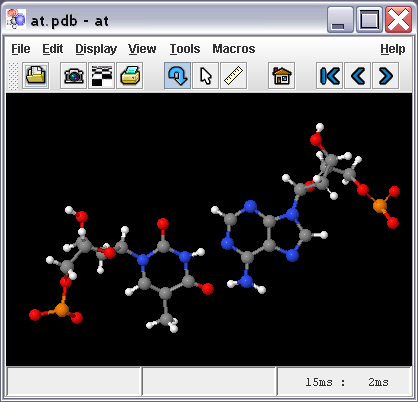Jmol Application
- Jmol as a standalone application.
- J(S)mol as a web applet or HTML5 object.
- compatibility with JavaScript frameworks or libraries.
- J(S)mol embedded in wikis or blogs.
- Borrowed JSmol, or running JSmol without your own server.
- Running Jmol using Java Web Start.
- JSmol in a Jupyter notebook.
- Jmol in an Android tablet.
- Troubleshooting.
Contents
Jmol Application
"Jmol Application" is the version of Jmol that runs as a standalone program, in its own window. It uses the Java programming language.
Control of the molecular model is gained through several means:
- The mouse (documented in Mouse Manual).
- The application's menu and toolbar (at the top of the window), which offer
- File open, export, and print functionalities.
- A limited set of selection and rendering options, and several tools.
- The pop-up menu (or context menu, opened by right-click or Ctrl+click on the model's panel), which offers most funcionality available and is identical to applet menu.
- The scripting language (same used by the applet); this is available through the File > Script... menu, which opens a "script console" or command-line environment.
Installing Jmol Application
- Get the files from SourceForge.
- Support and operating systems.
- Users: how to install Jmol application for local, standalone use.
- Web page authors: how to install Jmol objects (Jmol / JSmol) embedded within your web pages.
- Installing and Enabling Java (Proteopedia wiki). Has step by step instructions for both Windows and Mac OS X, and for the 5 most popular web browsers.
- Increasing java memory for the applet.
- Web site administrators:
- How to install the application on a web server to be delivered using Java Web Start.
- How to configure a wiki so that it uses the Jmol applet.
- Developers: compile the latest Jmol source code via subversion access.
Download Jmol package (either .zip or tar.gz format) and extract/uncompress only the ![]() Jmol.jar file to the folder of your choice.
Jmol.jar file to the folder of your choice.
To open the application, follow these instructions:
Starting Jmol Application
Several ways:
- Double-click on
 Jmol.jar file.
Jmol.jar file. - Click on a previously created shortcut (Windows terminology) (HowTo).
- Click on a previously created Start menu entry (Windows terminology) (HowTo).
- Execute one of the batch files/shell scripts that are part of Jmol distribution (Windows, MacOS, Linux, Unix).
- From the command line:
java -jar Jmol.jar(of course, issued from the folder/directory where Jmol.jar is, or else pointing to it with a full path). See memory options below. - Double-click on a molecular coordinates file whose extension has been previously associated to Jmol (HowTo).
- only for Macs, Fernanda Foertter has packed Jmol application into a clickable icon / .app type icon that opens up Jmol. This makes it look like a regular 'ol app without all of the exposed jar files. It is available at her site as a dmg file. Instructions: 1) download dmg file; 2) double-click to open; 3) drag Jmol icon to you Applications folder to install; 4) eject dmg; 5) trash dmg file; 6) double-click Jmol icon to open application, or 6a) click and drag to dock to have ready whenever needed.
Command line options
Basic options
- Show help for command-line options: use either of these:
java -h -jar Jmol.jar java -help -jar Jmol.jar java -? -jar Jmol.jar
- Load a molecular file: use either of these:
Jmol.jar fileName java -jar Jmol.jar fileName
- Run a script: use either of these:
Jmol.jar -s script_fileName Jmol.jar script_fileName java -jar Jmol.jar script_fileName
- Set the window size: use either of these:
Jmol.jar -g WIDTHxHEIGHT Jmol.jar --geometry WIDTHxHEIGHT java -jar Jmol.jar -g WIDTHxHEIGHT
using lowercase 'x' and no spaces, e.g. Jmol.jar -g 500x250.
By default, size is the last size used or else 500x500.
- Set the language to be used for the interface (default is language of the operating system) see also:
java -Duser.language=ca|cs|de|en|es|et|fr|nl|pt|tr -jar Jmol.jar
- Report the display speed in either frames per second or milliseconds per frame (the default):
java -Ddisplay.speed=fps|ms -jar Jmol.jar
- Set a path where to look for plugins for Jmol:
java -Dplugin.dir=/path/to/plugins -jar Jmol.jar
- Set memory use (see below):
java -Xmxsize -jar Jmol.jar
Giving Jmol more memory to work with
Memory available to Jmol is determined by Java. Less or more memory can be allocated by using:
java -Xmx###m -jar Jmol.jar
where the ### must be substituted by a number in megabytes (hence the "m" after it).
Technically:
- -Xmx sets the maximum memory heap size.
- -Xms sets the minimum memory heap size.
Batch files and shell scripts included with Jmol distribution are written to give -Xmx512m (512 MB maximum).
Advanced options (Jmol v.11)
Create a JVXL file directly:
Jmol -ionx iso.spt myfile.xyz > myfile.jvxl
where:
- -i,--silent silent startup operation
- -o,--noconsole no console -- all output to sysout
- -n,--nodisplay no display (much faster)
- -x,--exit run script and exit
and iso.spt is:
isosurface solvent;show isosurface
creates a JVXL solvent surface file.
Create a list of measurements:
Jmol -ionx measure.spt myfile.xyz > measure.txt
where measure.spt is:
measure allconnected (*) (*);show measurements
generates a list of measurements.
measure.txt now contains (tab-separated):
Measurement Information
distance 1.1217928 0.112 nm H 1 #1 C 10 #10
distance 1.4158994 0.142 nm N 2 #2 C 6 #6
distance 1.3865448 0.139 nm N 2 #2 C 7 #7
...
Check CIF file symmetry:
Jmol -ionx symmetry.spt myfile.cif > symmetry.txt
where symmetry.spt is:
show unitcell;show symmetry;show spacegroup;
Anything that can be "shown" can be dumped to a file this way. And anything you can get from getProperty will do the same.
Contributors
AngelHerraez, EricMartz, Pimpim, Cudo29, NicolasVervelle, Green
